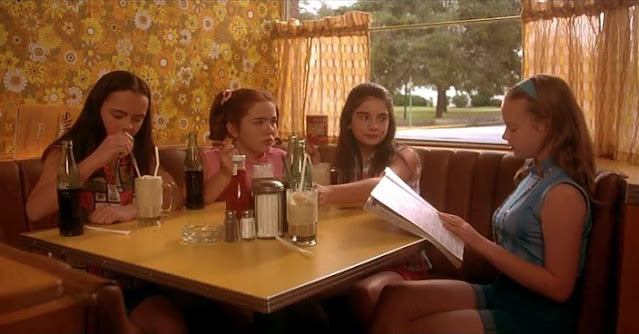Now and Then tells the story of four young girls during the summer of 1970. Samantha (Gaby Hoffman) is dealing with a family that is breaking apart. Her father has moved out of the house and she doesn’t know how to confide this with her friends whom she’s always portrayed her family life as being perfect. Chrissy (Ashleigh Aston Moore) is overly protected from the realities of life by her overbearing mother. Consequently she has no context for her feelings as she becomes sexually mature. This will affect her throughout her entire life. Teeny (Thora Birch) is a little self-absorbed, obsessed with becoming an actress like Marilyn Monroe. This obsession doesn’t prevent her from being a solid friend to the others although it will take her away from them as she grows up. Lastly, Roberta (Christina Ricci) is a tomboy, dealing with the death of her mother. She has been told it was peaceful but learns that it was actually a rather brutal death in a car accident, a death that was far from instantaneous. Roberta is determined to hide her femininity, strapping down her expanding chest line in hopes of stopping the progress into womanhood. She’s also prone to pranks where she pretends to be killed, much to the horror of her friends.
The story itself is, on the surface at least, pretty straightforward. The four girls perform a seance in a cemetery that leads them to believe someone buried there needs to be given peace. This leads the girls to research the death which exposes the truth about Roberta’s own mother’s death. During the search we get scenes depicting a rivalry between the girls and some boys as well as a chance encounter with a returned soldier from Vietnam (Brendan Frazier) who’s grateful for the wound he sustained that got him sent home. This stuff is superficial but paints a picture of the times. Lastly we get some character moments involving Crazy Pete, a loner in town who only comes out at night. The girls are afraid of him but will come to find that the old man is actually not so crazy after all.
The film does a good job painting a time in America that was transitional, something that parallels with the girls. This is a changing time for the country and for the girls as well. Samantha learns to open up to her friends, even when it’s about the fracturing of the family she had previously painted as being ideal. Roberta comes to grips with her mother’s death as well as having a brief moment of intimacy with one of the boys. The two least served characters, Chrissy and Teeny get a few moments, too, albeit nothing on the same level. Chrissy, sheltered from the realities of sex, is shocked when she sees several boys skinny dipping. Teeny sets aside selfishness, breaking her favorite necklace in half and giving half to Samantha to help comfort her over the divorce. It’s not a lot but it is moving nevertheless. One of the main drives is the girls’s plans to save up their money to build a treehouse in Chrissy’s backyard, something that eventually happens offscreen. These moments do not play out well in the bookend scenes that take place in the present featuring older actresses as the four main characters.
The bookend scenes amount to little in this film. In Stand By Me Richard Dreyfus’s narrates the film as an older version of one of the main characters. He serves to bring us up to speed on the rest of the characters but doesn’t really have his own story to tell. Now and Then, on the other hand, tries to bring us up to the present with a kind of reunion of the four girls after a long time apart. Teeny (Melanie Griffith) has indeed become an actress but we only know that because she rolls up in a stretch limo. Roberta (Rosie O’Donnell) is a gynecologist. Samantha (Demi Moore) writes Science Fiction and Chrissy (Rita Wilson) is expecting her first child, going into labor shortly after the girls get together. None of this amounts to much and actually undermines the drama from their childhood.
This film would have played better without the bookend scenes. Nothing in them adds to the film beyond a glimpse of the girl’s lives after they grew up and grew apart. Had it been written smarter and tied into the main story better this could have been good drama. Instead it feels tacked on, an opportunity for producer Demi Moore to insert herself and her actress friends into the film. When this film released it fell on deaf ears, failing to make a splash in the box office and with critics. It has since developed a cult following but it could have been more. The stories of the girls is poignant and the actresses playing the younger leads are all spot on, but certain characters, Chrissy and Teeny specifically, get underserved to make room in the runtime for their older counterparts. It lessens the film and dilutes the drama. The real life tragedy of Ashleigh Aston Moore adds another level to our feelings for her character after the fact.
Release Date: October 20, 1995
Running Time: 100 Minutes
Rated PG-13
Starring: Christina Ricci, Thora Birch, Gaby Hoffman, Ashleigh Aston Birch, Melanie Griffith, Demi Moore, Rosie O’Donnell and Rita Wilson
Directed By: Lesli Linka Glatter








Comments
Post a Comment